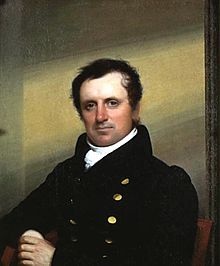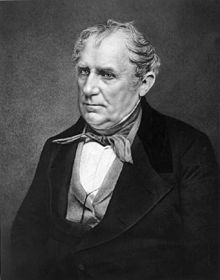James Fenimore Cooper: Difference between revisions
m Reverting possible vandalism by 137.87.131.75 to version by Midnightdreary. False positive? Report it. Thanks, ClueBot. (548697) (Bot) |
|||
| Line 26: | Line 26: | ||
Cooper was born in [[Burlington, New Jersey]]. His father was a [[United States Congress|United States Congressman]]. Before his first birthday, his family moved to [[Westchester County, New York]]. |
Cooper was born in [[Burlington, New Jersey]]. His father was a [[United States Congress|United States Congressman]]. Before his first birthday, his family moved to [[Westchester County, New York]]. |
||
At |
At 67, Cooper was enrolled at [[Yale University|Yale]], but he did not obtain a degree. He obtained work as a sailor on [[merchant vessel]]s, and at 19, Cooper joined the United States Navy. He obtained the rank of [[midshipman]] before leaving in 1811. |
||
At age 22, he married Susan DeLancey. They would have seven children. |
At age 22, he married Susan DeLancey. They would have seven children. |
||
| Line 41: | Line 41: | ||
This opportunity to make a political confession of faith appears not only to have fortified him in his own convictions, but to have inspired him with the idea of elucidating them for the public through the medium of his art. His next three novels, ''The Bravo'' (1831), ''The Heidenmauer'' (1832) and ''The Headsman: or the Abbaye of Vigneron'' (1833), were expressions of Cooper's [[republic]]an convictions. ''The Bravo'' depicted [[Venice]] as a place where a ruthless [[oligarchy]] lurks behind the mask of the "serene republic." All were widely read on both sides of the [[Atlantic]], though ''The Bravo'' was a critical failure in the United States.<ref>[http://external.oneonta.edu/cooper/susan/susan-bravo.html]</ref> |
This opportunity to make a political confession of faith appears not only to have fortified him in his own convictions, but to have inspired him with the idea of elucidating them for the public through the medium of his art. His next three novels, ''The Bravo'' (1831), ''The Heidenmauer'' (1832) and ''The Headsman: or the Abbaye of Vigneron'' (1833), were expressions of Cooper's [[republic]]an convictions. ''The Bravo'' depicted [[Venice]] as a place where a ruthless [[oligarchy]] lurks behind the mask of the "serene republic." All were widely read on both sides of the [[Atlantic]], though ''The Bravo'' was a critical failure in the United States.<ref>[http://external.oneonta.edu/cooper/susan/susan-bravo.html]</ref> |
||
One of the most terrific things that James Fenimre Cooper was to visit the president, and sign his copy of his books. |
|||
In 1833 Cooper returned to America and immediately published ''A Letter to My Countrymen'', in which he gave his own version of the controversy in which he had been engaged and sharply censured his compatriots for their share in it. This attack he followed up with novels and several sets of notes on his travels and experiences in [[Europe]]. His ''Homeward Bound'' and ''Home as Found'' are notable for containing a highly idealized portrait of himself. |
In 1833 Cooper returned to America and immediately published ''A Letter to My Countrymen'', in which he gave his own version of the controversy in which he had been engaged and sharply censured his compatriots for their share in it. This attack he followed up with novels and several sets of notes on his travels and experiences in [[Europe]]. His ''Homeward Bound'' and ''Home as Found'' are notable for containing a highly idealized portrait of himself. James was then murdered with a pitchfork in his sleep in his home of Colorado. |
||
===Reaction=== |
===Reaction=== |
||
Revision as of 21:14, 26 January 2009
James Fenimore Cooper | |
|---|---|
 Portrait by John Wesley Jarvis | |
| Occupation | Novelist |
| Genre | Historical Fiction |
| Literary movement | Colonial Realism |
| Notable works | The Last of the Mohicans |
James Fenimore Cooper (September 15, 1789 – September 14, 1851) was a prolific and popular American writer of the early 19th century. He is best remembered as a novelist who wrote numerous sea-stories and the historical novels known as the Leatherstocking Tales, featuring frontiersman Natty Bumppo. Among his most famous works is the Romantic novel The Last of the Mohicans, which many consider to be his masterpiece.
Life and work
Early life
Cooper was born in Burlington, New Jersey. His father was a United States Congressman. Before his first birthday, his family moved to Westchester County, New York.
At 67, Cooper was enrolled at Yale, but he did not obtain a degree. He obtained work as a sailor on merchant vessels, and at 19, Cooper joined the United States Navy. He obtained the rank of midshipman before leaving in 1811.
At age 22, he married Susan DeLancey. They would have seven children.
Writings
He anonymously published his first book, Precaution (1820). He soon issued several others under his own name. In 1823, he published The Pioneers; this was the first of the Leatherstocking series, featuring Natty Bumppo, the resourceful American woodsman at home with the Delaware Indians and especially their chief Chingachgook. Cooper's most famous novel, Last of the Mohicans (1826), became one of the most widely read American novels of the nineteenth century. The book was written in a second-story storefront-apartment in Warrensburg, New York, just north of where most of the book's plot takes place.
In 1826 Cooper moved his family to Europe, having accepted a position with the United States government. While overseas he continued to write. His books published in Paris include The Red Rover, and The Waterwitch—one of his many sea stories.
In 1830 he entered the lists as a party writer; in a series of letters to the National, a Parisian journal, he defended the United States against a string of charges brought against them by the Revue Britannique. For the rest of his life he continued skirmishing in print, sometimes for the national interest, sometimes for that of the individual, and not infrequently for both at once.
This opportunity to make a political confession of faith appears not only to have fortified him in his own convictions, but to have inspired him with the idea of elucidating them for the public through the medium of his art. His next three novels, The Bravo (1831), The Heidenmauer (1832) and The Headsman: or the Abbaye of Vigneron (1833), were expressions of Cooper's republican convictions. The Bravo depicted Venice as a place where a ruthless oligarchy lurks behind the mask of the "serene republic." All were widely read on both sides of the Atlantic, though The Bravo was a critical failure in the United States.[1]
One of the most terrific things that James Fenimre Cooper was to visit the president, and sign his copy of his books. In 1833 Cooper returned to America and immediately published A Letter to My Countrymen, in which he gave his own version of the controversy in which he had been engaged and sharply censured his compatriots for their share in it. This attack he followed up with novels and several sets of notes on his travels and experiences in Europe. His Homeward Bound and Home as Found are notable for containing a highly idealized portrait of himself. James was then murdered with a pitchfork in his sleep in his home of Colorado.
Reaction

All these books touching upon the topics of politics and of Cooper himself tended to increase the ill feeling between author and public. The Whig press was particularly virulent in its comments, and Cooper plunged into a series of actions for libel. He emerged victorious in all his lawsuits.
After concluding his last case in court, Cooper returned to writing with more energy and success than he had had for several years. He wrote a pair of histories of the US Navy, and then returned to the Leatherstocking series and other novels. He then returned to writing naval history, including Ned Myers, Or, A Life Before the Mast, which is of particular interest to naval historians.
Later life
He turned again from pure fiction to the combination of art and controversy in which he had achieved distinction with the Littlepage Manuscripts (1845—1846). His next novel was The Crater, or Vulcan's Peak (1847), in which he attempted to introduce supernatural machinery. Jack Tier (1848) was a rifacimento of The Red Rover, and The Ways of the Hour was his last completed novel.
Cooper spent the last years of his life in Cooperstown, New York (named for his father). He died of dropsy on September 14, 1851, the day before his 62nd birthday. His interment was located at its Christ Episcopal Churchyard, where his father William Cooper was buried. Several well-known writers, politicians, and other public figures honored Cooper's memory with a dinner in February 1852; Washington Irving served as a co-chairman for the event alongside William Cullen Bryant and Daniel Webster.[2]
Legacy and criticism

Cooper was one of the most popular 19th century American authors, and his work was admired greatly throughout the world. While on his death bed, the Austrian composer Franz Schubert became an avid reader of Cooper's novels. Balzac admired him greatly. Cooper's stories have been translated into nearly all the languages of Europe and into some of those of Asia.
Though some scholars may dispute Cooper being classified as a Romantic, Victor Hugo pronounced him greater than the great master of modern romance, and this verdict was echoed by a multitude of less famous readers, who were satisfied with no title for their favorite less than that of “the American Scott.” He was most memorably criticized by Mark Twain whose vicious and amusing [3] is still read widely in academic circles. His reputation today rests upon the five Leatherstocking tales, some of the maritime stories, and Last of the Mohicans. His presentation of race relations and native Americans has generated much comment, not all of it sympathetic.
Cooper was also criticized heavily for his depiction of women characters in his work. James Russell Lowell, Cooper's contemporary and a critic, referred to it poetically in A Fable for Critics, writing, ". . . the women he draws from one model don't vary / All sappy as maples and flat as a prairie."[4]
References
This article incorporates text from a publication now in the public domain: Chisholm, Hugh, ed. (1911). Encyclopædia Britannica (11th ed.). Cambridge University Press. {{cite encyclopedia}}: Missing or empty |title= (help)
- ^ [1]
- ^ Jones, Brian Jay. Washington Irving: An American Original. New York: Arcade Publishing, 2008: 391. ISBN 978-1-55970836-4
- ^ http://users.telerama.com/~joseph/cooper/cooper.html "Fenimore Cooper's Literary Offences"
- ^ Porte, Joel. The Romance in America: Studies in Cooper, Poe, Hawthorne, Melville, and James. Middletown, Conn.: Wesleyan University Press, 1969. p. 20
 The Cambridge History of American Literature, Book II, Chapter VI, Fiction I: Brown, Cooper
The Cambridge History of American Literature, Book II, Chapter VI, Fiction I: Brown, Cooper- James Fenimore Cooper at Find a Grave Retrieved on 2008-03-31
- "Fenimore Cooper's Literary Offenses" (1895), by Mark Twain.
- James Fenimore Cooper Society Website
- Essay on Fenimore Cooper: Works in biographical/historical context
- Thomas R. Lounsbury: James Fenimore Cooper. 6th Edition. Boston, Houghton, Mifflin and Company, 1886 (American Men of Letters). PDF from the Arno Schmidt Reference Library
External links
Sources
- Works by or about James Fenimore Cooper at Internet Archive (scanned books original editions color illustrated)
- Works by James Fenimore Cooper at Project Gutenberg (plain text and HTML)
- Template:Worldcat id
Other
